The NVIDIA GeForce GTX 980 Review: Maxwell Mark 2
by Ryan Smith on September 18, 2014 10:30 PM ESTOverclocking GTX 980
One of GTX 750 Ti’s more remarkable features was its overclocking headroom. GM107 could overclock so well that upon initial release, NVIDIA did not program in enough overclocking headroom in their drivers to allow for many GTX 750 Ti cards to be overclocked to their true limits. This is a legacy we would be glad to see repeated for GTX 980, and is a legacy we are going to put to the test.
As with NVIDIA’s Kepler cards, NVIDIA’s Maxwell cards are subject to NVIDIA’s stringent power and voltage limitations. Overvolting is limited to NVIDIA’s built in overvoltage function, which isn’t so much a voltage control as it is the ability to unlock 1-2 more boost bins and their associated voltages. Meanwhile TDP controls are limited to whatever value NVIDIA believes is safe for that model card, which can vary depending on its GPU and its power delivery design.
For GTX 980 we have a 125% TDP limit, meanwhile we are able to overvolt by 1 boost bin to 1265MHz, which utilizes a voltage of 1.25v.
| GeForce GTX 980 Overclocking | ||||
| Stock | Overclocked | |||
| Core Clock | 1126MHz | 1377MHz | ||
| Boost Clock | 1216MHz | 1466MHz | ||
| Max Boost Clock | 1265MHz | 1515MHz | ||
| Memory Clock | 7GHz | 7.8GHz | ||
| Max Voltage | 1.25v | 1.25v | ||
GTX 980 does not let us down, and like its lower end Maxwell 1 based counterpart the GTX 980 turns in an overclocking performance just short of absurd. Even without real voltage controls we were able to push another 250MHz (22%) out of our GM204 GPU, resulting in an overclocked base clock of 1377MHz and more amazingly an overclocked maximum boost clock of 1515MHz. That makes this the first NVIDIA card we have tested to surpass both 1.4GHz and 1.5GHz, all in one fell swoop.
This also leaves us wondering just how much farther GM204 could overclock if we were able to truly overvolt it. At 1.25v I’m not sure too much more voltage is good for the GPU in the long term – that’s already quite a bit of voltage for a TSMC 28nm process – but I suspect there is some untapped headroom left in the GPU at higher voltages.
Memory overclocking on the other hand doesn’t end up being quite as extreme, but we’ve known from the start that at 7GHz for the stock memory clock, we were already pushing the limits for GDDR5 and NVIDIA’s memory controllers. Still, we were able to work another 800MHz (11%) out of the memory subsystem, for a final memory clock of 7.8GHz.
Before we go to our full results, in light of GTX 980’s relatively narrow memory bus and NVIDIA’s color compression improvements, we quickly broke apart our core and memory overclock testing in order to test each separately. This is to see which overclock has more effect: the core overclock or the memory overclock. One would presume that the memory overclock is the more important given the narrow memory bus, but as it turns out that is not necessarily the case.
| GeForce GTX 980 Overclocking Performance | |||||
| Core (+22%) | Memroy (+11%) | Combined | |||
| Metro: LL |
+15%
|
+4%
|
+20%
|
||
| CoH2 |
+19%
|
+5%
|
+20%
|
||
| Bioshock |
+9%
|
+4%
|
+15%
|
||
| Battlefield 4 |
+10%
|
+6%
|
+17%
|
||
| Crysis 3 |
+12%
|
+5%
|
+15%
|
||
| TW: Rome 2 |
+16%
|
+7%
|
+20%
|
||
| Thief |
+12%
|
+6%
|
+16%
|
||
While the core overclock is greater overall to begin with, what we’re also seeing is that the performance gains relative to the size of the overclock consistently favor the core overclock to the memory overclock. With a handful of exceptions our 11% memory overclock is netting us less than a 6% increase in performance. Meanwhile our 22% core overclock is netting us a 12% increase or more. This despite the fact that when it comes to core overclocking, the GTX 980 is TDP limited; in many of these games it could clock higher if the TDP budget was large enough to accommodate higher sustained clockspeeds.
Memory overclocking is still effective, and it’s clear that GTX 980 spends some of its time memory bandwidth bottlenecked (otherwise we wouldn’t be seeing even these performance gains), but it’s simply not as effective as core overclocking. And since we have more core headroom than memory headroom in the first place, it’s a double win for core overclocking.

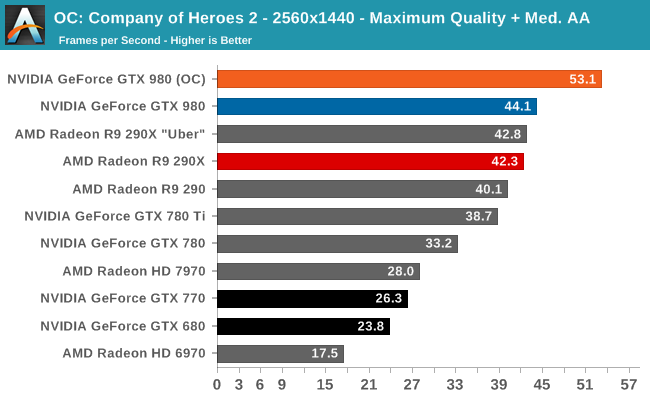
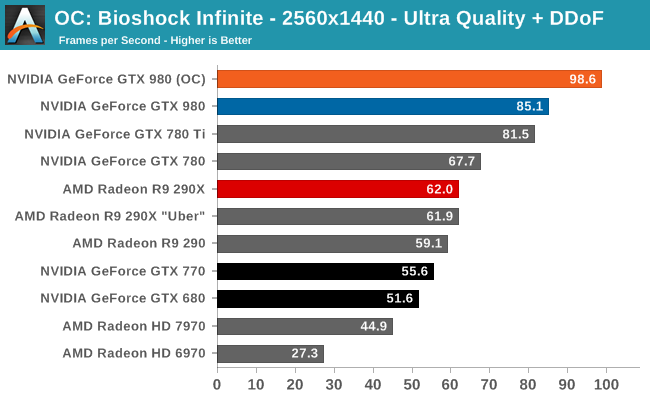
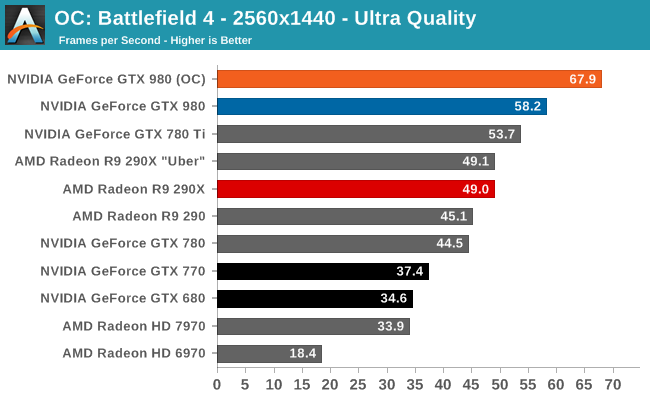
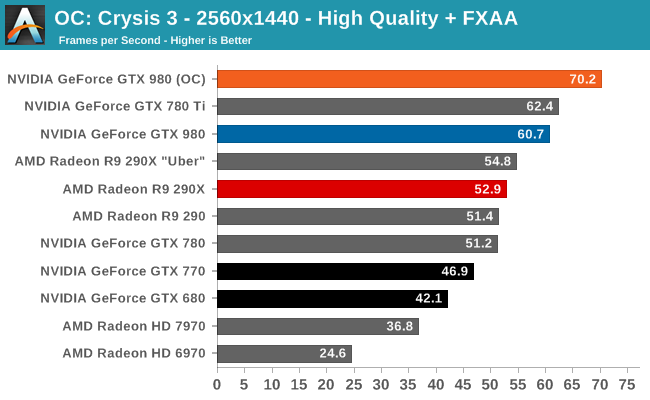
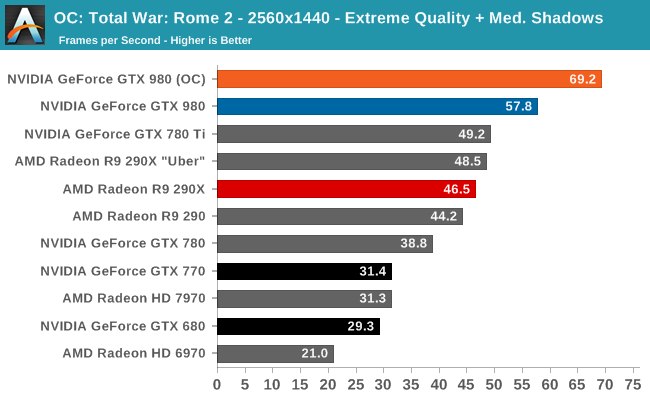
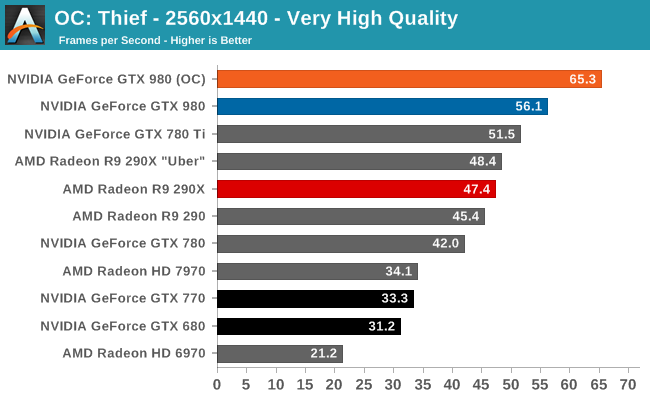
To put it simply, the GTX 980 was already topping the charts. Now with overclocking it’s another 15-20% faster yet. With this overclock factored in the GTX 980 is routinely 2x faster than the GTX 680, if not slightly more.
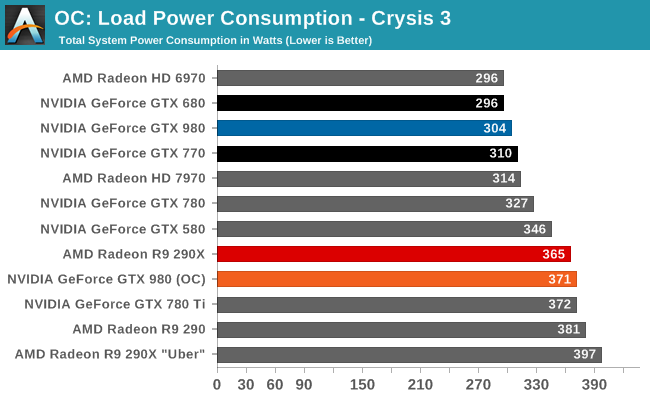
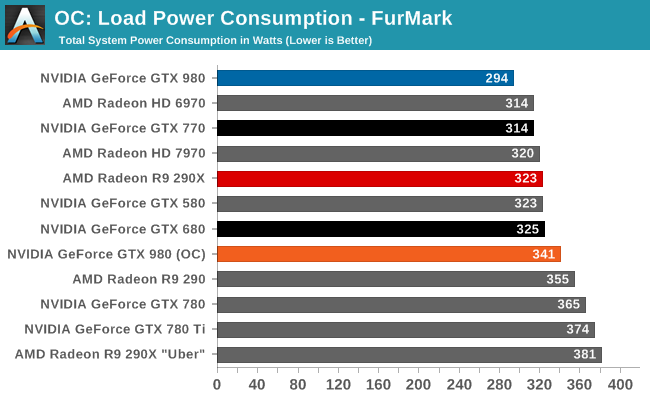
But you do pay for the overclock when it comes to power consumption. NVIDIA allows you to increase the TDP by 25%, and to hit these performance numbers you are going to need every bit of that. So what was once a 165W card is now a 205W card.


Even though overclocking involves raising the temperature limit to 91C, NVIDIA's fan curve naturally tops out at 84C. So even in the case of overclocking the GTX 980 isn't going to reach temperatures higher than the mid-80s.
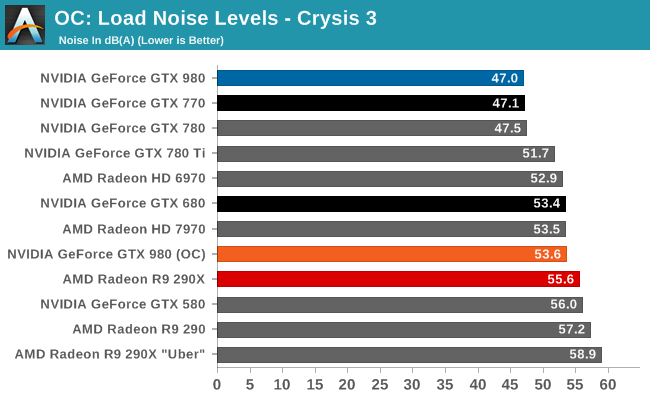

The noise penalty for overclocking is also pretty stiff. Since we're otherwise TDP limited, all of our workloads top out at 53.6dB, some 6.6dB higher than stock. In the big picture this means the overclocked GTX 980 is still in the middl of the pack, but it is noticably louder than before and louder than a few of NVIDIA's other cards. However interestingly enough it's no worse than the original stock GTX 680 at Crysis 3, and still better than said GTX 680 under FurMark. It's also still quieter than the stock Radeon R9 290X, not to mention the louder yet uber mode.










274 Comments
View All Comments
nathanddrews - Friday, September 19, 2014 - link
http://www.pcper.com/files/review/2014-09-18/power...kron123456789 - Friday, September 19, 2014 - link
Different tests, different results. That's nothing new.kron123456789 - Friday, September 19, 2014 - link
But, i still think that Nvidia isn't understated TDP of the 980 and 970.Friendly0Fire - Friday, September 19, 2014 - link
Misleading. If a card pumps out more frames (which the 980 most certainly does), it's going to drive up requirements for every other part of the system, AND it's going to obviously draw its maximum possible power. If you were to lock the framerate to a fixed value that all GPUs could reach the power savings would be more evident.Also, TDP is the heat generation, as has been said earlier here, which is correlated but not equal to power draw. Heat is waste energy, so the less heat you put out the more energy you actually use to work. All this means is that (surprise surprise) the Maxwell 2 cards are a lot more efficient than AMD's GCN.
shtldr - Wednesday, September 24, 2014 - link
"TDP is the heat generation, as has been said earlier here, which is correlated but not equal to power draw."The GPU is a system which consumes energy. Since the GPU does not use that energy to create mass (materialization) or chemical bonds (battery), where the energy goes is easily observed from the outside.
1) waste heat
2) moving air mass through the heatsink (fan)
3) signalling over connects (PCIe and monitor cable)
4) EM waves
5) degradation/burning out of card's components (GPU silicon damage, fan bearing wear etc.)
And that's it. The 1) is very dominant compared to the rest. There's no "hidden" work being done by the card. It would be against the law of conservation of energy (which is still valid, as far as I know).
Frenetic Pony - Friday, September 19, 2014 - link
That's a misunderstanding of what TDP has to do with desktop cards. Now for mobile stuff, that's great. But the bottlenecks for "Maxwell 2" isn't in TDP, it's in clockspeeds. Meaning the efficiency argument is useless if the end user doesn't care.Now, for certain fields the end user cares very much. Miners have apparently all moved onto ASIC stuff, but for other compute workloads any end user is going to choose NVIDIA currently, just to save on their electricity bill. For the consumer end user, TDP doesn't matter nearly as much unless you're really "Green" conscious or something. In that case AMD's 1 year old 290x competes on price for performance, and whatever AMD's update is it will do better.
It's hardly a death knell of AMD, not the best thing considering they were just outclassed for corporate type compute work. But for your typical consumer end user they aren't going to see any difference unless they're a fanboy one way or another, and why bother going after a strongly biased market like that?
pendantry - Friday, September 19, 2014 - link
While it's a fair argument that unless you're environmentally inclined the energy savings from lower TDP don't matter, I'd say a lot more people do care about reduced noise and heat. People generally might not care about saving $30 a year on their electricity bill, but why would you choose a hotter noisier component when there's no price or performance benefit to that choice.AMD GPUs now mirror the CPU situation where you can get close to performance parity if you're willing to accept a fairly large (~100W) power increase. Without heavy price incentives it's hard to convince the consumer to tolerate what is jokingly termed the "space heater" or "wind turbine" inconvenience that the AMD product presents.
Laststop311 - Friday, September 19, 2014 - link
actually the gpu's from amd do not mirror the cpu situation at all. amd' fx 9xxx with the huge tdp and all gets so outperformed by even the i7-4790k on almost everything and the 8 core i7-5960x obliterates it in everything, the performance of it's cpu's are NOT close to intels performance even with 100 extra watts. At least with the GPU's the performance is close to nvidias even if the power usage is not.TLDR amd's gpu situation does not mirror is cpu situation. cpu situation is far worse.
Laststop311 - Friday, September 19, 2014 - link
I as a consumer greatly care about the efficinecy and tdp and heat and noise not just the performance. I do not like hearing my PC. I switched to all noctua fans, all ssd storage, and platinum rated psu that only turns on its fan over 500 watts load. The only noise coming from my PC is my radeon 5870 card basically. So the fact this GPU is super quiet means no matter what amd does performance wise if it cant keep up noise wise they lose a sale with me as i'm sure many others.And im not a fanboy of either company i chose the 5870 over the gtx 480 when nvidia botched that card and made it a loud hot behemoth. And i'll just as quickly ditch amd for nvidia for the same reason.
Kvaern - Friday, September 19, 2014 - link
"For the consumer end user, TDP doesn't matter nearly as much unless you're really "Green""Or live in a country where taxes make up 75% of your power bill \